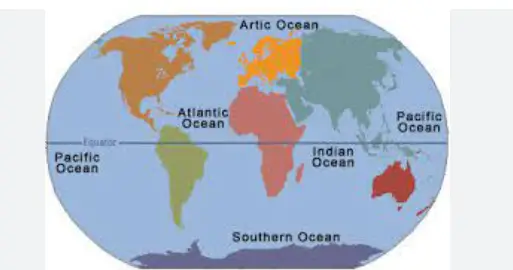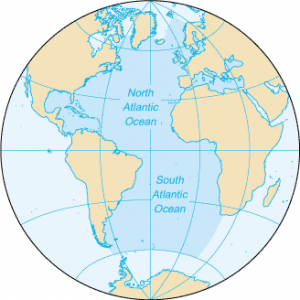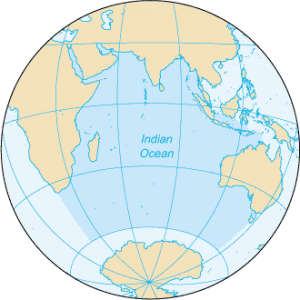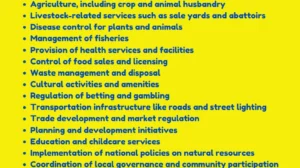The Pacific, Atlantic, Indian, Arctic, and the Southern Ocean, situated near Antarctica, collectively constitute the world’s five largest oceans.
Water covers 71% of the Earth’s surface.

Over time, the concept of oceans has transformed from a single vast body of water into something more complex.
The perception of whether there are five oceans largely depends on your geographical perspective.
Top 5 oceans In The World
1.Pacific Ocean
The Earth’s largest body of water, blankets over 30% of our planet’s surface, which accounts for nearly half of the total water on Earth.
This vast expanse extends along the western edges of the Americas and brushes against the coasts of East Asia and Australia.

The equator serves as the dividing line, cleaving the Pacific Ocean into two distinct regions: the North Pacific Ocean and the South Pacific Ocean.
The name “Pacific” originates from the Latin word for “peaceful.”
Remarkably, it boasts the deepest trenches on the planet, with an average depth of approximately 3,800 meters.
Also Read: How Many Women Are in the World? The Answer May Surprise You
2.The Atlantic Ocean
The Atlantic Ocean occupies the space between the continents of the Americas and Europe/Africa.
It is the world’s second-largest ocean and also the saltiest.

Its shape is reminiscent of the letter “S,” flowing between the landmasses of the Americas, Europe, and Africa.
The name “Atlantic” is derived from the Greek god “Atlas,” who bore the weight of the sky for all eternity.
Beneath its surface lies the mid-Atlantic Ridge;
A submerged mountain range that stretches from Iceland to 58 degrees South latitude, forming part of the world’s longest mountain range.
Throughout history, the Atlantic Ocean has witnessed extensive exploration by seafaring peoples such as the Vikings, Portuguese, and Christopher Columbus.
Today, it continues to serve as a vital conduit for trade routes like the transatlantic trade route.
3.The Indian Ocean
The Indian Ocean, ranks as the world’s third-largest ocean.
It envelops a densely populated region and holds an additional 20% of the Earth’s surface water.
Its boundaries encompass India to the north, East Africa, Australia, and the Southern Ocean.

Owing to its elevated water temperatures, the Indian Ocean supports a relatively limited marine ecosystem.
Also Read: Highest Paid Athlete In The World
For centuries, dating back to around 800 A.D., the Indian Ocean has played a pivotal role in global trade.
Navigators have relied on its major ocean currents to chart shipping routes.
Geologically speaking, the Indian Ocean is distinct among the world’s five oceans.
It is bordered by four tectonic plate boundaries and may even incorporate an additional plate boundary.
This ocean is the youngest in geological terms, featuring spreading ridges at divergent plate boundaries.
4.The Southern Ocean
In the year 2000, the International Hydrographic Organization officially recognized the Southern Ocean as the most recent addition to the family of Earth’s oceans.
It encompasses the entire periphery of Antarctica.

In terms of size, it ranks as the fourth-largest ocean, covering an expanse of 20,327,000 square kilometers, stretching all the way to the 60th parallel South.
This ocean presents an extreme and enigmatic environment, making it the least comprehended among the five oceans.
Its remoteness, harsh climate, and relative lack of exploration contribute to this mystery.
The Southern Ocean’s uncharted nature underscores a broader challenge in oceanic exploration, as approximately 80% of the world’s oceans remain unexplored.
There is still much work to be done to advance our understanding of the watery realms of our planet.
5.The Arctic Ocean
The Arctic Ocean, the smallest and shallowest among the world’s five oceans, also holds the titles of the coldest and least saline.
In terms of size, the Arctic Ocean spans an area roughly equivalent to that of Russia.

Its location near the North Pole means it is covered by polar ice, although the melting of glaciers over the years poses a significant threat to rising sea levels.
While officially recognized by the International Hydrographic Organization as the “Arctic Ocean,” some oceanographers still refer to it as the “Arctic Sea.”
In terms of biodiversity, the Arctic Ocean stands out due to its diverse range of fish species;
Which includes various marine life such as whales, jellyfish, and more.
However, the frigid temperatures in this region limit the presence of plant life, rendering it one of the most delicate ecosystems on our planet.



















































